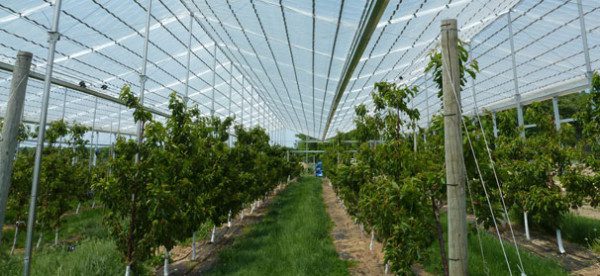
Jan 25, 2013Retractable-roof greenhouse protects sweet cherries
The gift of a retractable-roof greenhouse could be the first step toward a new method of protecting fruit from weather extremes.
In spring 2012, Cravo Equipment, a company based in Ontario, Canada, donated one of its X Frame greenhouses to Michigan State University (MSU). The greenhouse – made of steel and coated woven polyethylene fabric – was erected over a research plot of sweet cherry trees at the Clarksville Research Center. Greg Lang, an MSU professor and high tunnel expert, will study how well the X Frame protects the fruit.
The goal of the X Frame research, according to Cravo, is to “document and optimize the ability of the retractable roof to protect the crop from environmental risks, manipulate the timing of the harvests and increase fruit size, quality and yield.”
Lang called the X Frame the “Cadillac of all covered structures.”
“This is a dream for a researcher, to get this sort of environmental control over a research plot,” he said. “I never would have envisioned getting the finances to get one of these.”
Richard Vollebregt, Cravo’s president, valued the company’s donation at $96,400. MSU provided most of the labor for the installation, Lang said.
The new greenhouse was placed over a section of Lang’s best research plot, which is part of the NC-140 regional rootstock trials. The X Frame covers about half an acre of sweet cherry trees, mostly Bentons on Gisela 3, 5 and 6 rootstock. A covering system manufactured by VOEN covers another section of the research plot, while the rest is uncovered, he said.
Unfortunately, the X Frame wasn’t finished until May, right after a killer freeze came along in late April and wiped out all the cherries in the plot. The trees were planted in 2010, and 2012 was supposed to be their first cropping season, Lang said.
“We didn’t pick a single cherry in 2012,” he said.
Though the X Frame trials haven’t generated any hard data yet, Lang noticed the trees under the greenhouse recovered pretty quickly from a massive bacterial canker infection. Bacterial canker killed fruiting spurs throughout the research plot (and throughout Michigan) after last spring’s freeze, but the trees under the X Frame seemed to recover faster than the unprotected trees. Cherry trees in high tunnels have shown similar quick recoveries, he said.
One of the big advantages of the X Frame is automation. A computer, which receives data from a weather station, opens and closes the roof as needed. It’s much easier to deal with than a high tunnel, which has to be physically opened and closed, Lang said.
High tunnels protect cherries from rainfall, but not from another cause of cherry cracking: excessive water taken up through the roots. The X Frame’s roof slopes down to a gutter system, which carries water to the edge of the orchard. That way, rainwater stays clear of the root zone, which helps avoid cracking, Lang said.
The X Frame can accumulate growing degree day hours sooner than normal, which helps achieve an earlier harvest. Lang said it will give him “light years” more control over temperatures.
The retractable-roof design can work for other crops besides sweet cherries. With MSU colleague Eric Hanson, Lang plans to establish bagged raspberries under the X-Frame this year, in between sweet cherry blocks. They also will plant raspberries in the open, for comparison.
It was Cravo that initially approached Lang and MSU about the donation. The company was seeking an objective researcher who could study fruit growth under its X Frame product, preferably someone who was familiar with protective coverings. Industry experts recommended Lang, who’s been studying sweet cherries under high tunnels since 2005. Also, MSU is only a few hours away from Cravo by car; and Lynne Sage, one of Lang’s MSU colleagues, worked with Cravo in the recent past and was familiar with its retractable-roof technology, Vollebregt said.
The president of Cravo knows that the advantages of a retractable-roof greenhouse are evident to fruit growers. It’s the economics they need to figure out. Will the increased yields and better harvest timing be worth the investment?
The X Frame is three or four times more expensive than a high tunnel or a VOEN covering, but it’s much better at controlling weather factors. Growers will have to decide if the extra cost is worth the extra control, Lang said. Given more time, his research might help them make that decision.
For more on the MSU Clarksville station, click here.
By Matt Milkovich, Managing Editor
















